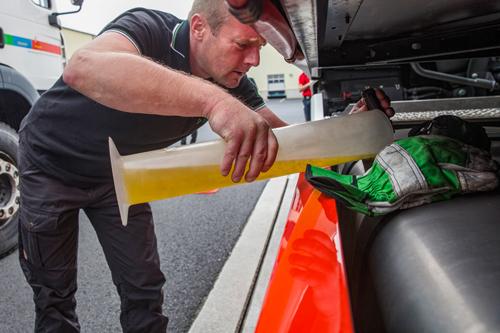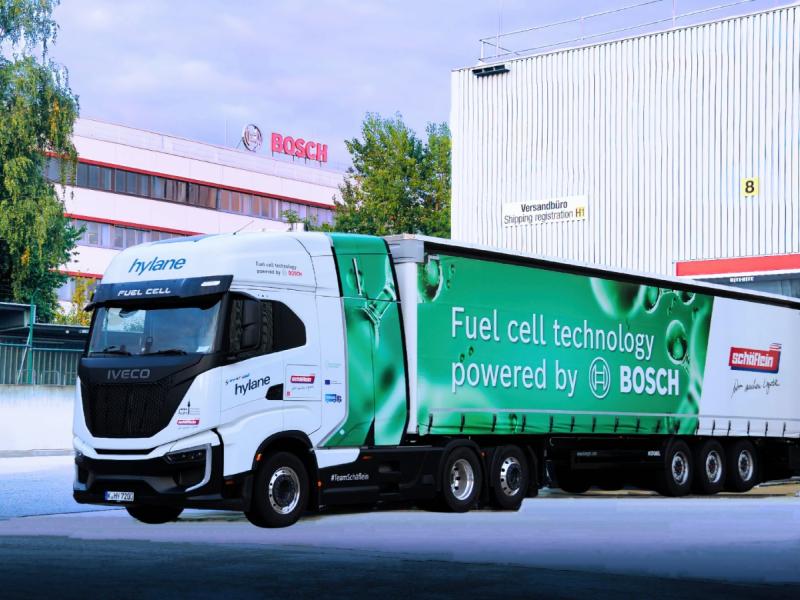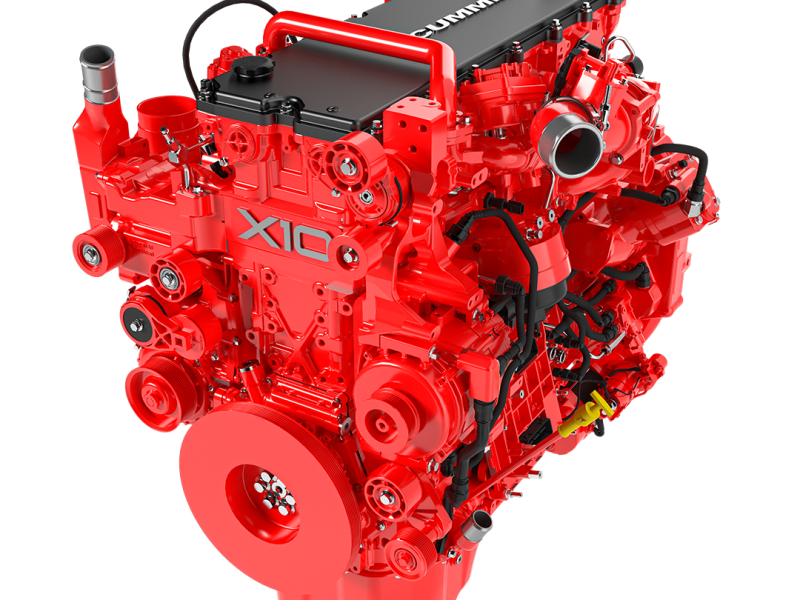Using technologies available on the market, the fuel consumption, and therefore the CO2 emissions, of modern truck combinations can be reduced by a double-digit percentage. This was the finding of a field test, the results of which were presented in Berlin on October 19 by Daimler Trucks, together with the project participants.
These results from a field test called Efficiency Run will be of great significance in the future for achieving CO2 targets for road freight transport. This is because the Efficiency Run has demonstrated that fuel consumption, and therefore also CO2 emissions, can be significantly reduced – also at lower cost – if optimisation efforts focus not just on the engine of the tractor unit, but on the vehicle as a whole.
Additional significant CO2 reductions, which could add up from factors such as specific fuels, fleet operations or driver training, have not yet been considered in this field test.
The series of tests was conducted by Daimler Trucks in cooperation with the leading German logistics companies DB Schenker Logistics, Grosse-Vehne and Elflein. This involved genuine freight being driven on genuine routes under realistic conditions. The tests were supervised in detail by the DEKRA testing organisation, which laid down the test conditions, carried out the measurements and evaluated the results.
One of the key results: the two Mercedes-Benz Actros standard semi-trailer combinations that were optimised for the Efficiency Run each consumed around 12 to 14 percent less fuel than standard semi-trailer combinations of the respective transport companies based on their fleets in 2014.
The Efficiency Run also investigated the potential of the Long Combination Vehicle – once again with a clear result. In the test, the standard Long Combination Vehicle showed a reduction in consumption of around 17 percent compared with the standard semi-trailer combination used in volume-based transport.
Expectations exceeded
“We have proven that if we want to significantly further reduce both fuel consumption and CO2 emissions, we need to look beyond just the engine. We must widen our focus to include tyres, semitrailer and other key components. This is the only way in which we can achieve our objective in an affordable manner,” saidDr. Wolfgang Bernhard, member of the board of management of Daimler AG responsible for Daimler Trucks & Buses.
“Our test also confirms the formula that two Long Combination Vehicles have the same transport capacity as three conventional semi-trailer combinations – with significantly higher efficiency and lower impact on the environment.”.
Stefan Buchner, head of Mercedes-Benz Trucks added: “Our aim is to ensure that customers who buy a Mercedes-Benz Actros have the most efficient vehicle in its class. So, naturally, we were especially keen to see how much more optimisation is possible on the vehicle as a whole. Reductions of up to 14 percent on the standard semi-trailer combination clearly exceeded our expectations.”
CO2 reduction
European commercial-vehicle manufacturers have already achieved a great deal on the CO2 front: for example, fuel consumption per tonne/km has been reduced by around 60 percent since 1965, and, over the same period six exhaust emissions standards have been put into practice. This demonstrates that the most effective regulator for a commercial-vehicle manufacturer is the customer.
The EU intends to achieve a CO2 reduction of 30 percent by 2030, compared with 2005. For Germany, a reduction of even 40 percent is under discussion. Against this backdrop, says Daimler Trucks, it is necessary to adopt new approaches, because it is no longer enough to focus exclusively on the tractor unit. To be able in future to achieve even more significant – yet affordable – reductions in CO2 emissions, politicians and the transport industry must join forces and adopt an integrated approach.
The goal, says Daimler Trucks, is to adopt an integrated approach in which all the actors involved in road freight transport take part in achieving the targets: commercial-vehicle manufacturers, body/tyre suppliers, logistics companies and, last but not least, politicians. Daimler Trucks presented this concept together with other European manufacturers at the 2014 IAA for Commercial Vehicles.
The objective of the integrated approach is to optimise the entire truck/transport system. In addition to the tractor unit, consideration is given also to the semitrailer (e.g. weights and dimensions, air resistance, lightweight design), tyres (e.g. rolling resistance, air pressure, single tyres) and fuel (e.g. biofuel, natural gas).
Yet the integrated approach also attaches importance to vehicle operation (e.g. driver training, cargo pooling), infrastructure and the issue of fleet renewal. The Efficiency Run has now demonstrated that the integrated approach works in real-world practice.
Efficiency Run
For the Efficiency Run, Daimler Trucks and the three logistics companies focused on the vehicle-specific optimisation potential. The requirements for the Efficiency Run can be reduced to a simple formula: as close to the real world as possible.
This means that the test had to use standard tractor units with standard powertrains. The vehicles in the configuration Actros 1842 with 3,700mm wheelbase were optimised exclusively using components that are currently available on the market.
Sporting distinctive red/white colours, the two Actros Efficiency Run semi-trailer combinations from the fleets of DB Schenker and Grosse-Vehne that took part in the field test were equipped with Predictive Powertrain Control (PPC).
The Actros tractor units were hooked up to weight-optimised Krone Eco semitrailers, which are likewise available on the market in this form. Optimisation of the vehicles was rounded off with low rolling-resistance tyres. The Long Combination Vehicle with a two-axle Actros 1845 tractor unit and four-axle semitrailer was identical to the standard combinations used by the third participating transport company, Elflein.
The reference vehicles for the one-week tests were standard semi-trailer combinations of the three transport companies with similar mileages to those of the Efficiency Run vehicles.
During the field test, the drivers of the trucks were accompanied by DEKRA test engineers, who manually recorded every event, such as traffic jams, traffic light stops, manoeuvres, empty trips and “slipstreaming”, in order to assess the relevance of external influences. Special care was taken to accurately measure the fuel consumption.
During the tests, the trucks were refuelled by a calibrated tanker vehicle to guarantee an identical fuel quality and temperature. The DEKRA experts filled up the vehicles first with the pump nozzle and then using a measuring glass.
Said Uwe Burckhardt, deputy head of the DEKRA Automobile Test Centre: “We wanted the comparison between the reference vehicles from the fleets of the participating companies and the consumption-optimised vehicles to take place under realistic conditions, be reproducible and deliver meaningful results of high quality. We went to considerable lengths to achieve this.”
A comprehensive evaluation of the collected data by DEKRA delivered a clear result: fuel consumption can already today be optimised at acceptable cost using components available on the market. It is now up to each of the participants to ensure that the tested solutions are actually put into widespread practice on the roads.






